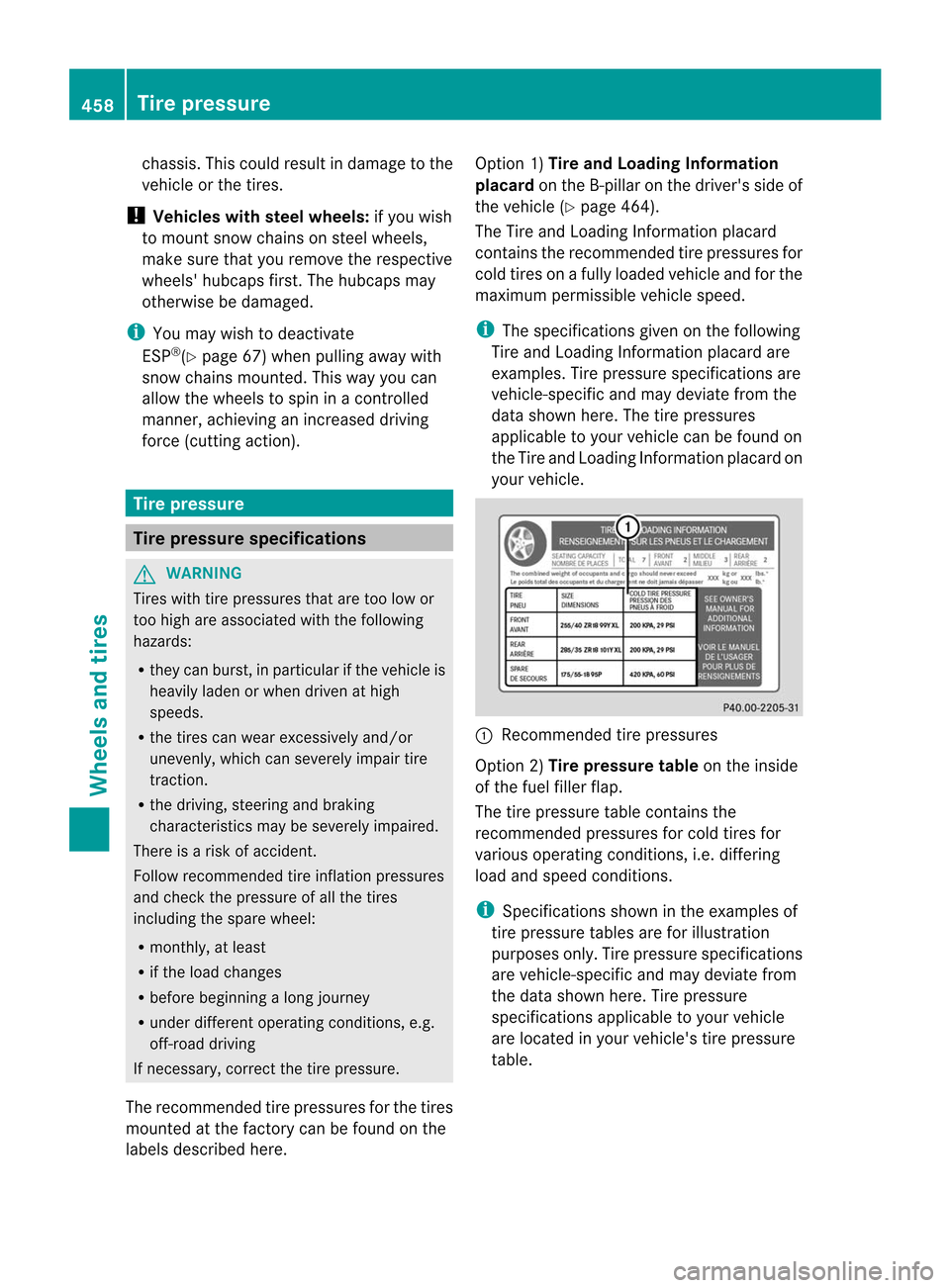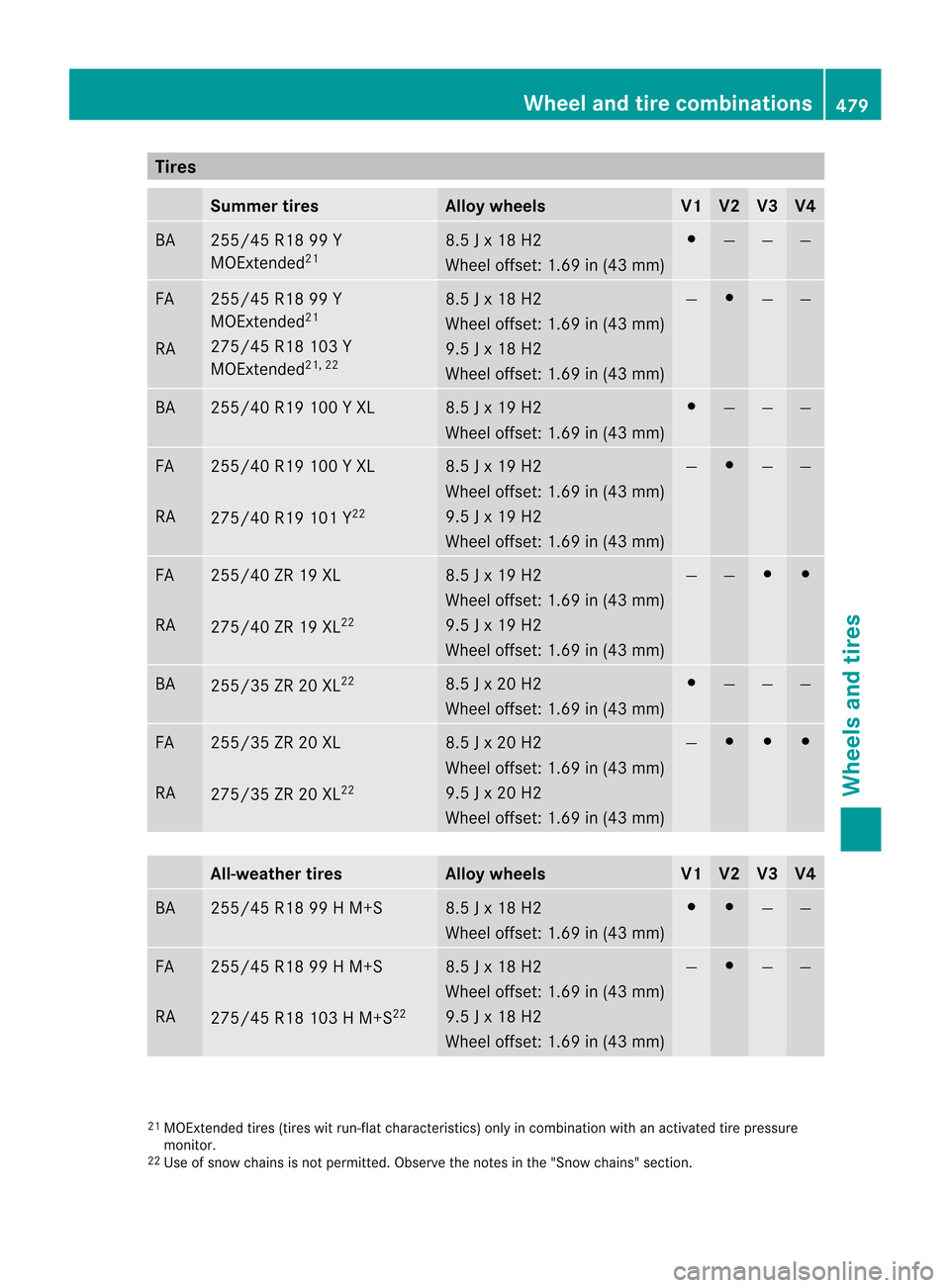snow chains MERCEDES-BENZ CL-Class 2014 C217 User Guide
[x] Cancel search | Manufacturer: MERCEDES-BENZ, Model Year: 2014, Model line: CL-Class, Model: MERCEDES-BENZ CL-Class 2014 C217Pages: 494, PDF Size: 13.55 MB
Page 459 of 494

conditions
.Only these tires will allow driving
safety systems such as ABS and ESP ®
to
functio noptimally in winter .These tires have
been developed specifically for driving in
snow.
Use M+S tires of the same make and tread on
all wheels to maintain safe handling
characteristics. G
WARNING
M+S tires with a tire tread depth of less than
ã in (4 mm) are not suitable for use in winter
and do not provide sufficient traction. There
is a risk of an accident.
M+S tires with a tread depth of less than ã
in (4 mm) must be replaced immediately.
Always observe the maximum permissible
speed specified for the M+S tires you have
mounted.
When you have mounted M+S tires:
X Check the tire pressures (Y page 461).
X Restart the tire pressure monitor
(Y page 461).
After mounting a spare wheel or an
emergency spare wheel, do not drive faster
than 50 mph (80 km/h). G
WARNING
The wheel or tire size as well as the tire type
of the spare wheel or emergency spare wheel
and the wheel to be replaced may differ.
Mounting an emergency spare wheel may
severely impair the driving characteristics.
There is a risk of an accident.
To avoid hazardous situations:
R adapt your driving style accordingly and
drive carefully.
R never mount more than one spare wheel or
emergency spare wheel that differs in size.
R only use a spare wheel or emergency spare
wheel of a different size briefly.
R do not switch ESP ®
off.
R have a spare wheel or emergency spare
wheel of a different size replaced at the nearest qualified specialist workshop.
Observe that the wheel and tire dimensions
as well as the tire type must be correct.
Snow chains
For safety reasons, Mercedes-Benz
recommends that you only use snow chains
that have been specially approved for your
vehicle by Mercedes-Benz, or are of a
corresponding standard of quality.
! You must drive at raised vehicle level if
snow chains have been mounted. The
vehicle could otherwise be damaged.
! On some tire sizes there is not enough
space for snow chains. To avoid damage to
the vehicle or tires, observe the "Wheel and
tire combinations" section under "Tires and
wheels".
If you intend to mount snow chains, please
bear the following points in mind:
R Snow chains may not be mounted on all
wheel/tire combinations. Permissible
wheel-tire combinations (Y page 477).
R Mount snow chains only in pairs and only
on the rear wheels. Observe the
manufacturer's mounting instructions.
R Only use snow chains when driving on
roads completely covered by snow.
Remove the snow chains as soon as
possible when you come to aroad that is
not snow-covered.
R Local regulations may restrict the use of
snow chains. Observe the appropriate
regulations if you wish to mount snow
chains.
R Do not exceed the maximum permissible
speed of 30 mph (50 km/h).
R Snow chains may not be mounted on the
emergency spare wheel.
! If snow chains are mounted on the front
wheels, the snow chains could grind
against the bodywork or components of the Winter operation
457Wheels and tires Z
Page 460 of 494

chassis. This could result in damage to the
vehicle or the tires.
! Vehicles with steel wheels: if you wish
to mount snow chains on steel wheels,
make sure that you remove the respective
wheels' hubcaps first. The hubcaps may
otherwise be damaged.
i You may wish to deactivate
ESP ®
(Y page 67) when pulling away with
snow chains mounted. This way you can
allow the wheels to spi ninacontrolled
manner, achieving an increased driving
force (cutting action). Tire pressure
Tire pressure specifications
G
WARNING
Tires with tire pressures that are too low or
too high are associated with the following
hazards:
R they can burst, in particula rifthe vehicle is
heavily laden or when driven at high
speeds.
R the tires can wear excessively and/or
unevenly, which can severely impair tire
traction.
R the driving, steering and braking
characteristics may be severely impaired.
There is a risk of accident.
Follow recommended tire inflation pressures
and check the pressure of all the tires
including the spare wheel:
R monthly, at least
R if the load changes
R before beginning a long journey
R under different operating conditions, e.g.
off-road driving
If necessary, correct the tire pressure.
The recommended tire pressures for the tires
mounted at the factory can be found on the
labels described here. Option 1)
Tire and Loading Information
placard on the B-pillar on the driver's side of
the vehicle (Y page 464).
The Tire and Loading Information placard
contains the recommended tire pressures for
cold tires on a fully loaded vehicle and for the
maximum permissible vehicle speed.
i The specifications given on the following
Tire and Loading Information placard are
examples. Tire pressure specifications are
vehicle-specific and may deviate from the
data shown here. The tire pressures
applicable to your vehicle can be found on
the Tire and Loading Information placard on
your vehicle. :
Recommended tire pressures
Option 2) Tire pressure table on the inside
of the fuel filler flap.
The tire pressure table contains the
recommended pressures for cold tires for
various operating conditions, i.e. differing
load and speed conditions.
i Specifications shown in the examples of
tire pressure tables are for illustration
purposes only. Tire pressure specifications
are vehicle-specific and may deviate from
the data shown here. Tire pressure
specifications applicable to your vehicle
are located in your vehicle's tire pressure
table. 458
Tire pressureWheels and tires
Page 481 of 494

Tires
Summer tires Allo
ywheels V1 V2 V3 V4
BA 255/45 R18 99 Y
MOExtended
21 8.5 J x 18 H2
Wheel offset: 1.69 in
(43 mm) #
— — —
FA
RA 255/45 R18 99 Y
MOExtended
21
275/45 R18 103 Y
MOExtended 21, 22 8.5 J x 18 H2
Wheel offset: 1.69 in
(43 mm)
9.5 J x 18 H2
Wheel offset: 1.69 in (43 mm) — #
— —
BA 255/40 R19 100 Y XL 8.5 J x 19 H2
Wheel offset: 1.69 in
(43 mm) #
— — —
FA
RA 255/40 R19 100 Y XL
275/40 R19 101 Y
22 8.5 J x 19 H2
Wheel offset: 1.69 in
(43 mm)
9.5 J x 19 H2
Wheel offset: 1.69 in (43 mm) — #
— —
FA
RA 255/40 ZR 19 XL
275/40 ZR 19 XL
22 8.5 J x 19 H2
Wheel offset: 1.69 in
(43 mm)
9.5 J x 19 H2
Wheel offset: 1.69 in (43 mm) — — # #
BA
255/35 ZR 20 XL
22 8.5 J x 20 H2
Wheel offset: 1.69 in
(43 mm) #
— — —
FA
RA 255/35 ZR 20 XL
275/35 ZR 20 XL
22 8.5 J x 20 H2
Wheel offset: 1.69 in
(43 mm)
9.5 J x 20 H2
Wheel offset: 1.69 in (43 mm) — # # #
All-weather tires Alloy wheels V1 V2 V3 V4
BA 255/45 R18 99 H M+S 8.5 J x 18 H2
Wheel offset: 1.69 in
(43 mm) # #
— —
FA
RA 255/45 R18 99 H M+S
275/45 R18 103 H M+S
22 8.5 J x 18 H2
Wheel offset: 1.69 in
(43 mm)
9.5 J x 18 H2
Wheel offset: 1.69 in (43 mm) — #
— —
21
MOExtended tires (tires wit run-fla tcharacteristics) only in combination with an activated tire pressure
monitor.
22 Use of snow chains is not permitted. Observe the notes in the "Snow chains" section. Wheel and tire combinations
479Wheels and tires Z
Page 482 of 494

All-weather tires Alloy wheels V1 V2 V3 V4
BA 255/40 R19 100 V XL M+S 8.5 J x 19 H2
Wheel offset: 1.69 in
(43 mm) # #
— —
FA
RA 255/40 R19 100 V XL M+S
275/40 R19 101 V M+S
22 8.5 J x 19 H2
Wheel offset: 1.69 in
(43 mm)
9.5 J x 19 H2
Wheel offset: 1.69 in (43 mm) — #
— —
Winter tires Alloy wheels V1 V2 V3 V4
BA 255/45 R18 99 V M+S
i 8.5 J x 18 H2
Wheel offset: 1.69 in
(43 mm) # #
— —
BA 255/40 R19 100 V XL
M+Si 8.5 J x 19 H2
Wheel offset: 1.69 in
(43 mm) # # # #
FA
RA 255/40 R19 100 V XL
M+Si
275/40 R19 105 V XL
M+Si
22 8.5 J x 19 H2
Wheel offset: 1.69 in
(43 mm)
9.5 J x 19 H2
Wheel offset: 1.69 in (43 mm) — — # #
"Minispare" emergency spare wheel
22Tires Wheels V1 V2 V3 V4
T 155/70 R19 113 M
Tire pressure: 420 kPa (4.2 bar/
61 psi) 4.5 B x 19 H2
Wheel offset: 1.38 in
(35 mm) # # # #
i
The specified tire pressure is printed in yellow on the emergency spare wheel.
22 Use of snow chains is not permitted. Observe the notes in the "Snow chains" section. 480
Wheel and tire combinationsWheels and tires